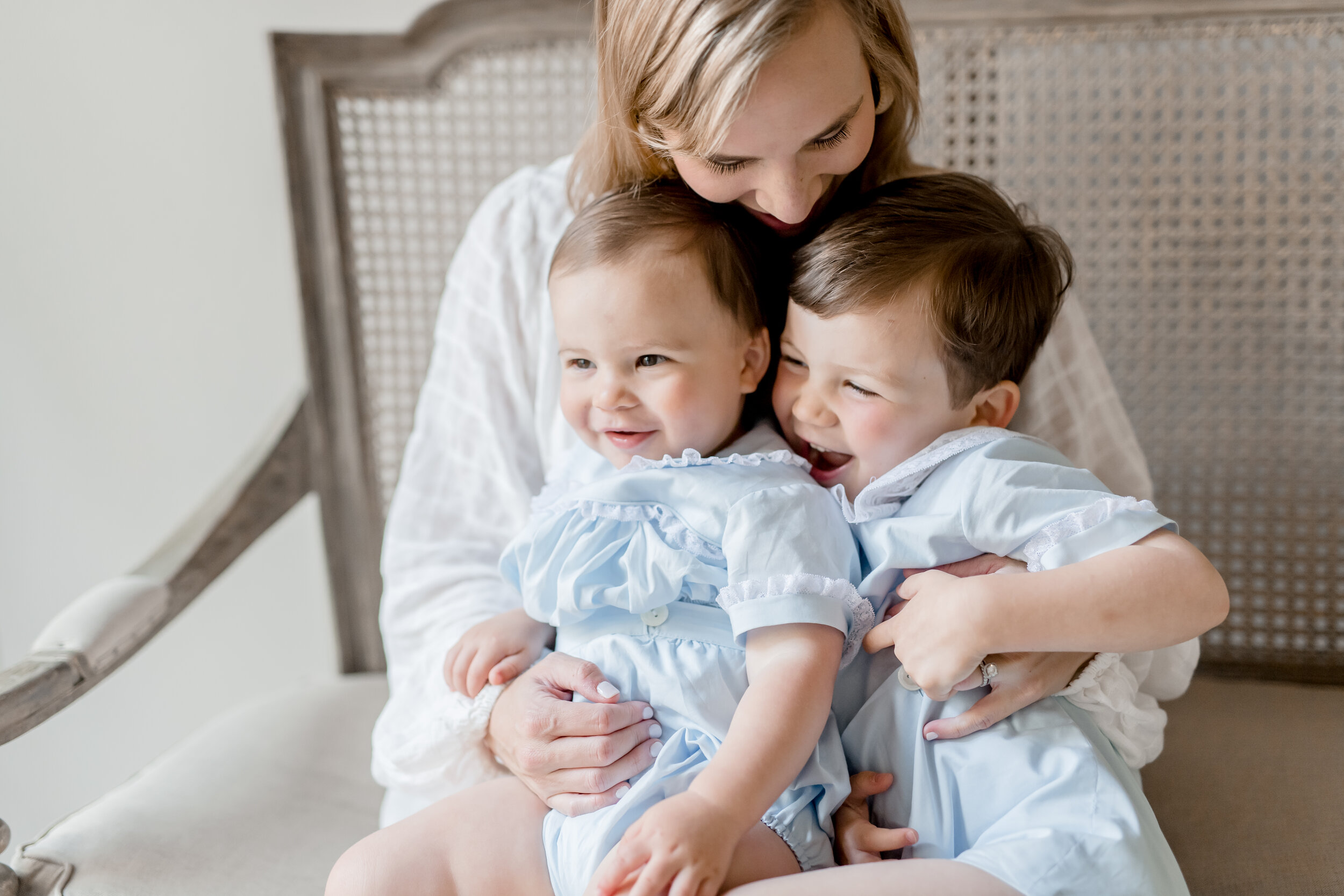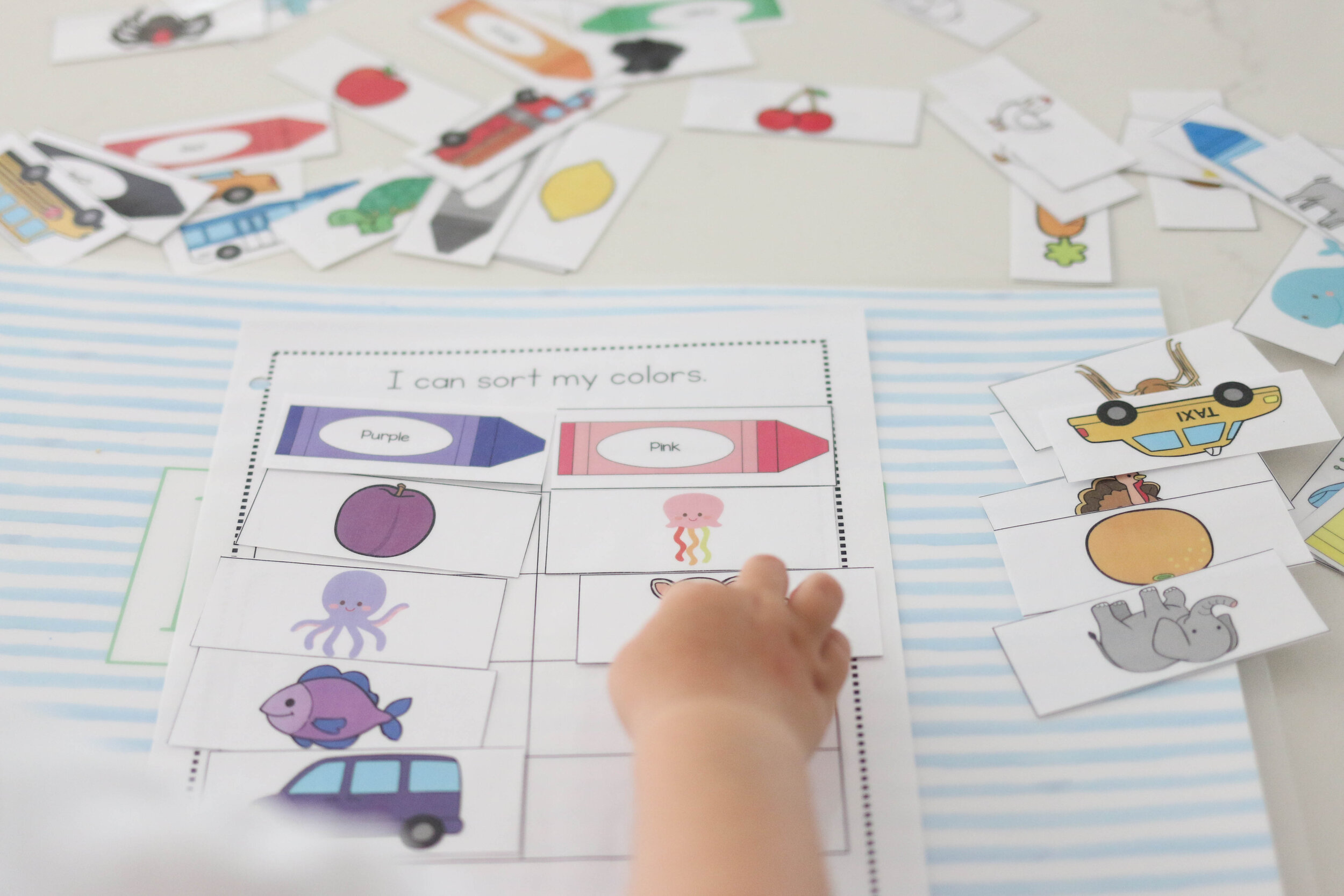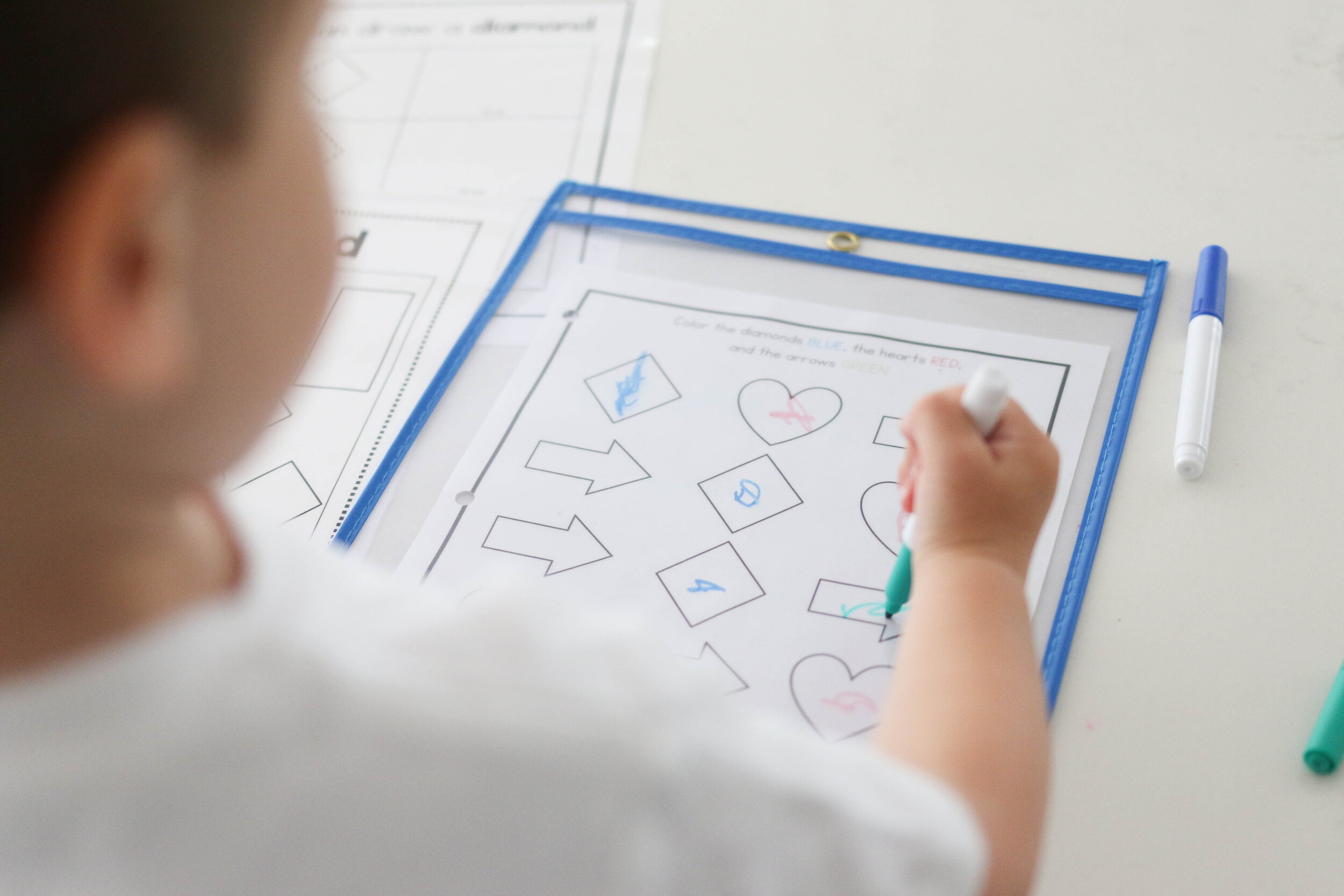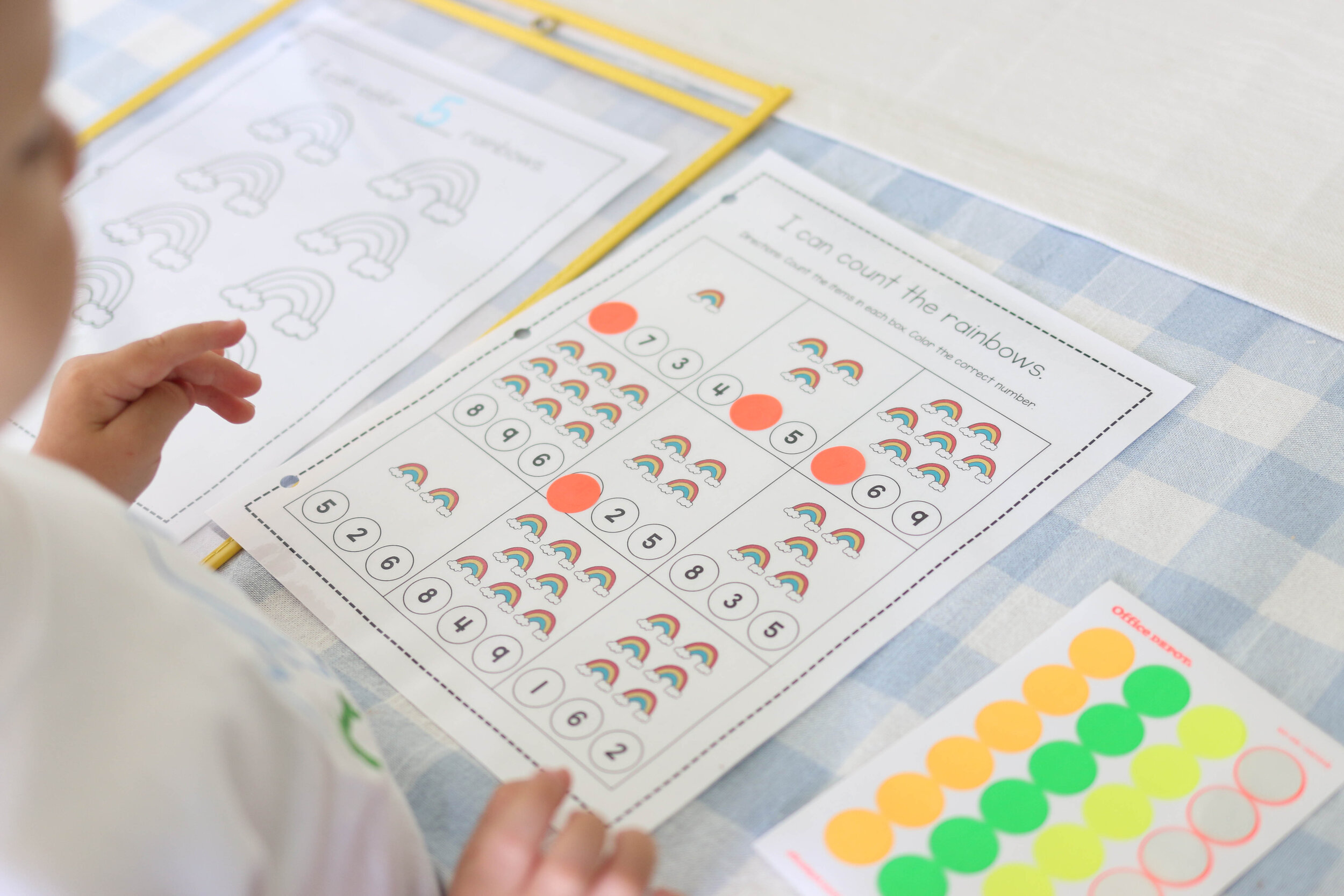How I Teach My Children
Hey friends! I’m so glad you’re here and ready to read about how I teach my toddlers! In the following paragraphs, I’m referencing my experience teaching my oldest child who just turned 4. I’m currently teaching my 19 month old using the same progression and resources. For more information about each individual resource, you can browse my blog posts. You can view and purchase my resources in my Teachers Pay Teachers store. To see my resources in action, you can browse my Instagram highlights (@francieoutlaw).
Teaching Colors
18 months is a developmentally appropriate age to begin teaching colors to your child. Of course, some children will learn their colors sooner and some later. My Toddler Learning Resource is filled with activities to teach your child to recognize and classify colors. Here’s a peek at how we learn colors in our home:
18 months+
The Toddler Learning Resource has several activities for teaching colors to our early learners. The following activities are the perfect place to begin:
- “I can match the crayons.”
- “I can match my colors.”
- “I can sort my colors.”
- Color flash cards
Books are a wonderful way to teach your child to recognize colors. Here are a handful of our favorites:
- Pete the Cat, I love my White Shoes
Also, don’t forget the power of conversation. Notice colors in the world around you and identify them to your child. You might say, “Your strawberries are red!” or “Your cup is blue!” or “Your shirt is yellow!” When your child masters a color, celebrate!!! Reference that color often and help your child develop a sense of pride for learning a color.
20 months+
When my son was around 20-21 months old, I began focusing on one color at a time. Using the Toddler Learning Resource, I focused on one color each week. The resource covers 11 colors. You can teach the colors in any order you choose! Before I began teaching, I used our flash cards to assess which colors my child already knew. I chose to begin with the colors he was already familiar with so that we could officially master those first. Here’s a list of the Color activities we kept in our Learning Folder each week:
- “I can match the crayons.”
- “I can match my colors.”
- “I can sort my colors.”
- Color of the Week pages
o Color Song
o Color Poster
o Circle the objects that are _______
o Circle the objects that are _______
o I can find the ______ objects
o Color Matching
o Color Activities
- Color flash cards
Pinterest is filled with hands-on sorting activities that we love to implement in our home. You can click here to see my Colors Pinterest board for some inspiration! Our favorites are sorting toys by color and sticker matching!
This is also an appropriate time to begin introducing art to your child. In our home, we love dot markers and dot stickers. You can also finger paint, watercolor, and color with crayons. While it may be a messy experience, it gives you the opportunity to set clear boundaries at an early age. However, you also want to set your child up for success. We use these placemats to keep our countertop safe (you can use the code FRANCIE15 for 15% off), and I have my little boy paint in paint-safe clothing. Even so, he was still expected to learn how to carefully use our art supplies!
As my child learned colors, we continued implementing our favorite Pinterest activities and reading books about colors. Repetition is important, so don’t forget to continue recognizing and identifying colors in everyday life. We kept our Toddler Learning Resource color matching pages & flash cards in our Learning folder for several months after my child had mastered identifying colors.
*A quick note moving forward. My child called the color red “yeah” for months. However, it was consistent and he thought he was saying “red”. After a lot of correction and repetition, he eventually verbalized the word “red”. Just keep this in mind as your child’s language skills develop.
Teaching Shapes
2 years old is the perfect time to begin teaching your child basic shapes. My Toddler Learning Resource teaches 9 beginning shapes. Your child will practice prewriting skills and shape identification. As prewriting skills develop, your child can learn to draw each shape independently.
I mentioned above that I recommend teaching one color per week. Once you’ve completed those 11 weeks of learning, I recommend introducing shapes, one shape per week. Here’s what we kept in our learning folder each week as we learned our shapes:
Toddler Learning Resource
- “I know my shapes” matching
- Shape of the Week Pages
o I can trace a ________
o I can draw a ________
o Color all the ________
o I can find the _______
o Color the ________ blue, the ________ red, and the ________ green.
We also loved this Melissa and Doug shape puzzle! Whenever I use a puzzle to teach my child a new word or concept, we play a game called “Where, oh where?”. In reference to teaching shapes, I would sing, “Where, oh where is the star?” and my child would match the star then wait for me to sing again! I would sing, “Where, oh where is the circle?” and my child would match the circle. This game became familiar and enjoyable for both of us!
Literacy
Literacy is a broad term, and the truth that your tiny toddler will learn to read seems a bit daunting. There are six early literacy skills your child needs in order to excel as a beginning reader. Let’s take a look at these skills and learn how we, as parents, can address them.
1. Print Motivation
We want our children to love books! Your job is to help your child develop a love of reading. Teach your child to love books and read to them often! Start reading to your child at a young age and read every single day.
2. Print Awareness
Teach your child how books work. Point out the title, author, text, and illustrations. Teach them how to hold a book, turn pages, and use your finger to show them how you’re reading from left to right. We want our children to notice and understand that there are words on the page.
3. Vocabulary
Teach your child new words. This is going to happen via intentional learning, yet it can also happen very naturally via conversation. Talk with your children. Conversation is extremely important, so use your words. My Toddler Learning Resource matching activities are perfect for helping develop your child’s vocabulary at a young age. I began using these activities with my children around 18 months old. Here’s an example of how you can use and extend the matching activities to grow vocabulary and knowledge:
Let’s say you are matching the picture of a horse. Via this matching card, your child can learn the word “horse” but you can also initiate conversations about what the horse says, what the horse eats, where the horse lives, etc. To learn more about this resource, click here.
4. Narrative Skills
We need to teach our children to tell stories. We need to enter into conversations with them, ask them questions, model answers, and encourage their growth.
5. Letter Knowledge
A beginning reader needs to recognize letters. Most children will recognize letters between ages 3 and 4. My Toddler Alphabet Resource includes the following pages:
o I can recognize the letter
o I can trace the letter
o I can write the letter
o Letter poster
o Letter songs
o Alphabet Art pages
o I can find the letter (uppercase)
o I can find the letter (lowercase)
The main goals of this resource are letter identification, letter formation, and phonological awareness. You can learn more about this resource here.
Around 2 years old, my child began noticing letters and singing the alphabet song. I began “A Letter of the Week” routine. Each week, we would focus on one letter. I began with the letters of my child’s name (M, I, L, and S). He was thrilled to be able to recognize and spell his own name! After, I chose to go in alphabetical order. Using the activities within my Toddler Alphabet Resource, I taught both uppercase and lowercase letters simultaneously, with a focus on uppercase letters. Once all uppercase letters were mastered, we reviewed lowercase letters. Alongside my resource, we loved using these magnets and this puzzle.
There are many ways to teach letter identification, so always do your own research and choose what is best for your family! You can find more ideas on this Pinterest board.
You’ll notice in the Toddler Alphabet Resource that there are tracing and writing pages. As my child learned to identify the letters, I had him finger trace each letter along the way. Once he mastered letter identification, we then began to focus more on letter formation. For reference, by ages 4 or 5, children will begin writing letters. Here’s the order that I chose to teach uppercase letter formation:
E, F, H, I, L, T, V, W, X, K, M, N, Y, A, Z, C, O, G, Q, B, D, J, P, U, R, S
*Remember, I’m just sharing what works for our family! Always do your own research when making decisions on how to teach your child!
6. Phonological Awareness
The last early literacy skill is teaching your child to recognize sounds in words. While some programs say you should teach sounds first, I believe it’s important to teach letter names first. I love this post by This Reading Mama. She gives 3 great reasons for teaching letter names before letter sounds.
I taught my son letter sounds through a lot of repetition. We would use the letter songs in my Toddler Alphabet Resource. When we drove in the car I would say “A says /a/, B says /b/” and my child would listen and repeat. We also watched different videos on YouTube. We love this one and this one. Essentially, teaching letter sounds in our home consisted of a lot of repetition.
*If you follow my Instagram account (@francieoutlaw) you’ve probably seen that I am now teaching my oldest to read. I don’t plan to create any of my own reading resources, but I’ll leave a link here to the resource that I am using to teach my child to read. If you’re looking for an option that doesn’t require any printing or setup, this one was also recommended to me!
Early Math Skills
There are several early math skills you’ll want to focus on as you prepare your child for Kindergarten. Here’s a quick list of topics I teach through my resources:
o Identify 2D Shapes – Toddler Learning Resource
o Classify Colors – Toddler Learning Resource
o Patterns – Toddler Learning Resource
o Count to 10 – Toddler Number Resource: Numbers 1-10.
o Count to 20 – Toddler Number Resource: Numbers 1-20.
o Understand Cardinality – I cover this in my Toddler Number Resources. Cardinality is the understanding that the last number used to count a set of objects represents how many objects are in the group. Essentially, your child can count objects and tell “how many”.
o Write Numbers – Toddler Number Resources
A few other important early math skills are topics such as observation, problem solving, spatial sense, classifying, ordering, comparing, measurement, and graphing. One of the most important concepts is number sense, which encompasses all of these topics. It means our children have moved beyond the memorization component of math (ex: counting) and are making sense of the numbers. In our home, number sense grows mostly through conversations and visual representations.
My Toddler Number Resources focus on number identification, counting, and cardinality. I began teaching my child Numbers 0-10 when he was around 2 years old. First, we began with teaching him to verbally count to 10. Lots of repetition and memorization! We loved to listen to this song while teaching him to count to 10.
Once this milestone was met, I used my resources and this puzzle to teach number identification. We began with recognizing numbers 0, 1, 5, and 10. Next, we focused on 2, 3, and 4. Finally, we focused on 6, 7, 8, and 9. Each week, we would focus on one number using the following pages:
- I can recognize the number _____
- I can trace the number _____
- I can write the number _____
- I can find the number _____
- Dot Marker number activity page
- “I can match the numbers” matching page
We would also use the number matching page and the Melissa and Doug puzzle to review all the numbers.
After my child mastered number identification, we began to focus on cardinality. Most children will count to 10 by 4 years old. The Toddler Number Resource is FILLED with counting activities. Each day, we would do 1-2 of the activity pages. My child would count the objects and then identify the number that represented the set of objects. When I first introduced these activities, I modeled a LOT. These activities might be my child’s favorite within my resources. As we used the pages to learn about counting, we also began counting more in our daily lives. We would count stairs, foods on our plate, objects in our grocery cart, etc. We always love to give real world context to the work we’re doing on paper. This helps develop number sense!
Once Numbers 0-10 were mastered, we moved onto the Toddler Number Resource: Numbers 11-20. Our process was similar. We practiced counting to 20, we learned to identify the numbers 11-20, then we learned to count objects within 20. My child was ready for the Toddler Number Resource: Numbers 11-20 just before 3 years old. Most children will learn to count to 20 by 5 years old.
So, What Are My Goals?
Remember, these are all academic goals for your child. It so important to focus on other valuable life skills. Our children are learning to share and cooperate with others. Their imaginations are growing. Their gross motor and fine motor skills are developing. There is so much room for biblical training and character development, and we don’t want to miss those moments because we’re too focused on academic skills. Are they important? I believe they are. But let’s make sure we’re helping shape well-rounded children with smart brains AND big hearts. With that in mind, here’s my list of Pre-K goals to make sure our kiddos are academically ready for Kindergarten.
o I know my colors.
o I can identify shapes.
o I know all 26 capital letters.
o I know all 26 lowercase letters.
o I know all the letter sounds.
o I can complete a pattern.
o I can count to 20.
o I can count and tell how many.
o I can write the numbers 1-10.
o I can listen to a story and tell what it is about.
o I can draw a picture and tell a story to match.
o I can rhyme.
o I can write my name.
o I know my birthday.
o I know my phone number.
o I know my address.
o I can identify the beginning sound of a word.
o I can identify the ending sound of a word.
o I can read 10 sight words.
How Do I Plan Our Learning?
Below you’ll find my Learning Plan template along with samples of how I might fill out this template for my child at different ages. The ages listed on these templates list the earliest ages that that particular learning plan would be appropriate. Notice, I keep many review concepts in the Learning Folder while focusing on 1-2 new skills each week. In our home, I kept blank copies of the Learning Plan in my child’s Learning Folder. Each week, I would fill out what learning concepts we would focus on that week. The Learning Plan kept me focused and allowed our learning to be fluid. If we had a crazy week or my child didn’t master a specific skill, we could simply repeat that skill the following week. The Learning Plan kept me accountable, organized, and ready to teach my child! Click here to download the Learning Plan template.
Alright friends, that’s all I have for you! Thanks so much for taking the time to read all of my thoughts. I hope this is so helpful for you as you teach your little ones. If you ever have any questions, you can reach out to me on Instagram (@francieoutlaw) or email me at heyfrancieoutlaw.com.














